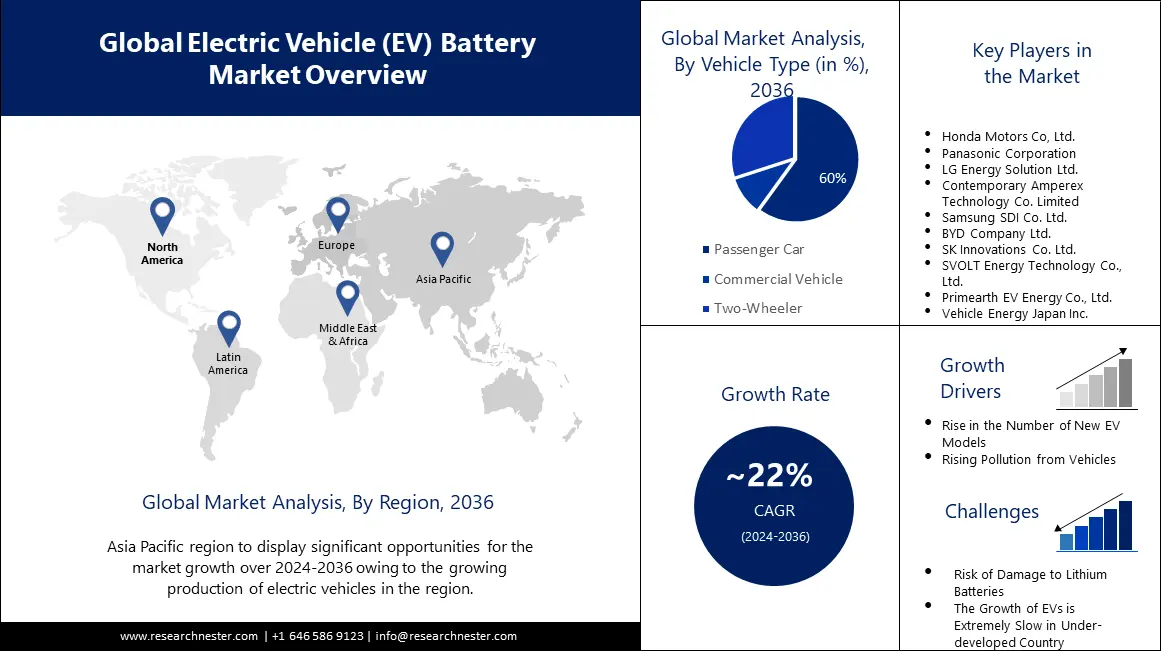
EV Battery Market size is expected to reach USD 624.07 Billion by the end of 2036, growing at a CAGR of approximately 22% during the forecast period, i.e., 2024 - 2036. In the year 2023, the industry size of EV battery was USD 57.4 Billion. The growth of the market can be attributed to the rising need to save oil and gas, this factor is propelling nations all across the world to deploy electric vehicles. Around 50 TWh of electricity, or less than 0.5% of current global final electricity consumption, was used by the world's EV fleet in 2021. Moreover, in the same year, the adoption of EVs reduced oil consumption by about 0.3 Mb/d. In order to comply with the Net Zero Scenario in 2030, EVs would need to replace more than 7 Mb/d of oil.
In addition to these, factors that are believed to fuel the market growth of electric vehicle batteries include rising demand for electric vehicles which in turn is likely to boost the demand for batteries. According to the International Energy Agency, after ten years of exponential development, the number of electric cars sold worldwide reached 10 million in 2020, a rise of 43% over 2019. Moreover, in 2020, battery electric vehicles (BEVs) made up two-thirds of the stock and all new electric car registrations. Furthermore, in 2021, around 6.6 million electric cars were sold and sales of EV accounted for about 10% of all vehicle sales worldwide.

Growth Drivers
Challenges
|
Base Year |
2023 |
|
Forecast Year |
2024-2036 |
|
CAGR |
~22% |
|
Base Year Market Size (2023) |
~ USD 57.4 Billion |
|
Forecast Year Market Size (2036) |
~ USD 624.07 Billion |
|
Regional Scope |
|
Vehicle Type (Passenger Car, Commercial Vehicle, Two-Wheeler)
The passenger segment is estimated to hold 60% share of the EV battery market in the year 2036. The growth of the segment can be attributed to the rising demand for passenger electric cars. The demand for passenger electric vehicles is rising quickly; the International Energy Agency predicts that by 2022, almost 13% of all new cars sold are to be electric. Furthermore, regionally speaking, in 2020, 35 million electric passenger cars were sold in China, followed by Europe, where 1.8 million cars were sold. Passenger cars contribute heavily to air pollution, therefore substituting gas-passenger cars with electric cars is likely to be a great solution and is also expected to boost the market growth.
Battery Type (Lithium-Ion, Nickel Metal Hydride, Lead Acid)
EV battery market from the lithium-ion battery segment is expected to gamer a significant share of approximately 50% in the year 2036. The growth of the segment is expected to grow on account of rising demand for lithium-ion batteries. On the other hand, compared to lead-acid batteries, lithium-ion batteries have a higher energy density and a longer lifespan. Owing to this, lead acid batteries are being phased out of many applications, including grid and transportation, and being replaced by lithium-ion batteries.
Our in-depth analysis of the global market includes the following segments:
|
Vehicle Type |
|
|
Battery Type |
|
|
Propulsion Type |
|
APAC Market Forecast
The EV battery market in Asia Pacific is projected to generate the largest share of about 35% by the end of 2036. This growth could be owing to the growing production of electric vehicles. In 2021, the Asia-Pacific market for electric car production increased by double digits over the preceding year to 122,243 units. Moreover, this region also has the presence of major market players which is also boosting the market expansion in this region.
North American Market Analysis
The North America EV battery market is also estimated to have notable growth over the forecast period. The growth of the market can be attributed majorly to the increasing investment for boosting the manufacturing of electric vehicle. In the manufacturing of electric vehicles and batteries, the United States is now prepared to draw the greatest amount of foreign investment. Since President Biden's appointment in 2021, companies have announced investments totaling around USD 210 billion in the EV battery industry.



Author Credits: Payel Roy, Dhruv Bhatia
FREE Sample Copy includes market overview, growth trends, statistical charts & tables, forecast estimates, and much more.
Have questions before ordering this report?